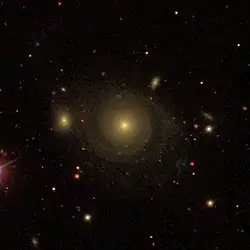NGC 262
NGC 262 (also known as Markarian 348) is a spiral galaxy in the cluster LGG 14.[1] It is a Seyfert 2 spiral galaxy located 287 million light years away in the constellation Andromeda.[2] It was discovered on September 17, 1885 by Lewis A. Swift.
| NGC 262 | |
|---|---|
 NGC 262 as imaged by the SDSS. | |
| Observation data (J2000 epoch) | |
| Constellation | Andromeda |
| Right ascension | 00h 48m 47.14154s[1] |
| Declination | +31° 57′ 25.08″[1] |
| Distance | 287 million light-years (88 Mpc)[2] |
| Apparent magnitude (V) | 13.1 |
| Characteristics | |
| Type | S0a |
| Apparent size (V) | 1,1' × 1,1' |
| Other designations | |
| 2MASX J00484711+3157249, UGC 499, Markarian 348 [1] | |
Size
This galaxy has an apparent diameter of 1.1' of the Earth's sky.[3] It holds approximately 15 trillion stars. [NGC 262] was tidally disturbed by the gravitational forces of smaller galaxies, which resulted in its large size.[3]
NGC 262 is very unusual, since it is 10 times larger than a regular spiral galaxy of its type.[2] According to Morris and Wannier, NGC 262 is surrounded by a huge cloud of neutral hydrogen[2] that is probably caused by the tidal stripping of smaller galaxies. The cloud has an apparent mass of approximately 50 billion solar masses[2] at a distance of 88 kiloparsecs (287,000 light-years)[2] from the nucleus of NGC 262 and extending up to 300 kiloparsecs (1 million light-years) away.[2] The cloud is spiral shaped with at least one arm, and possibly another one extending throughout the galaxy.
References
- "SIMBAD query result". Basic data for NGC 262.
- Huchra, J. (May 15, 1980). "The optical properties of the unusual galaxy Markarian 348". The Astrophysical Journal. 238: 11–12. Bibcode:1980ApJ...238L..11H. doi:10.1086/183246.
- "The New York Times". Distant galaxy found to be largest known. 1987-03-13.